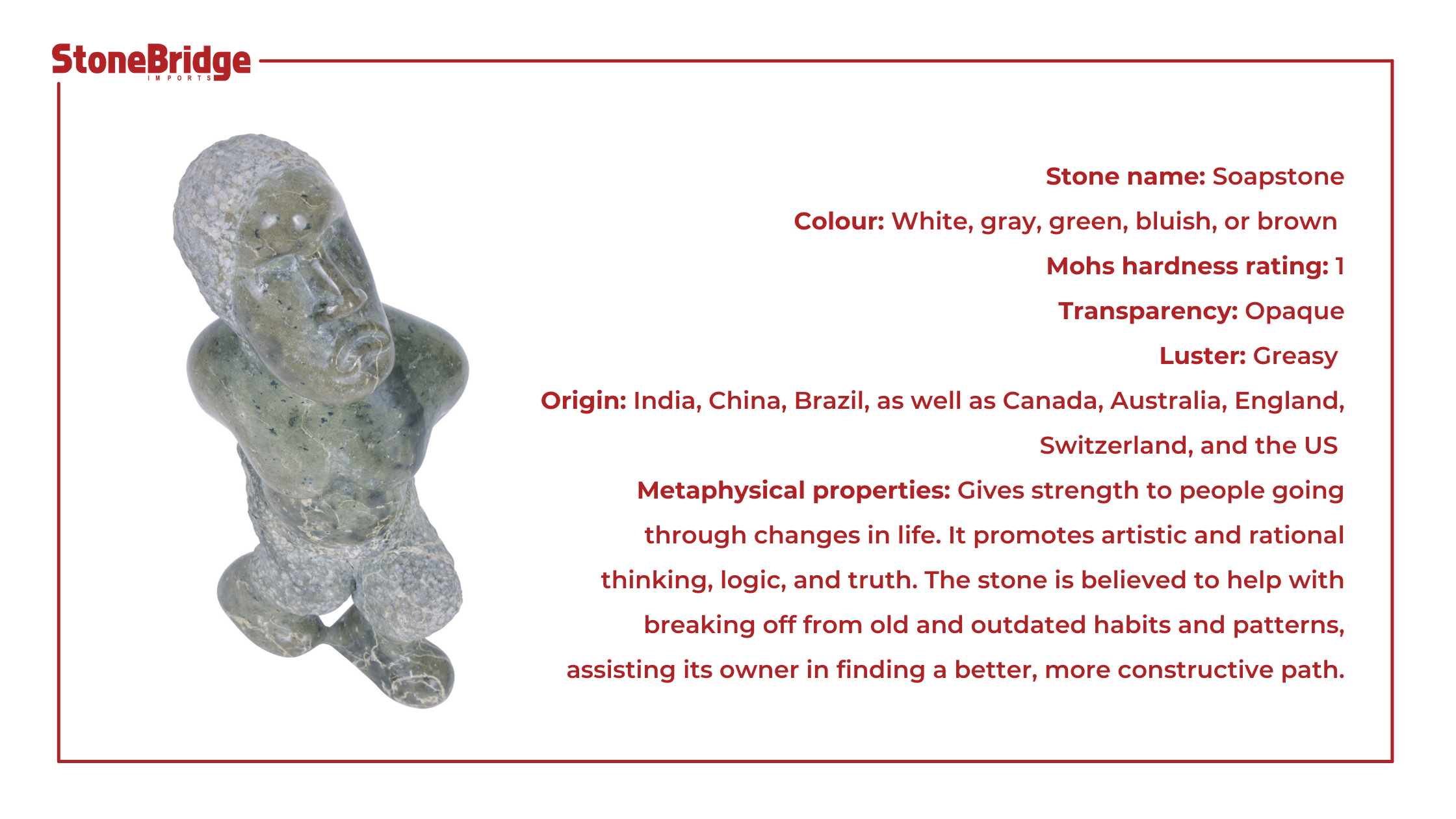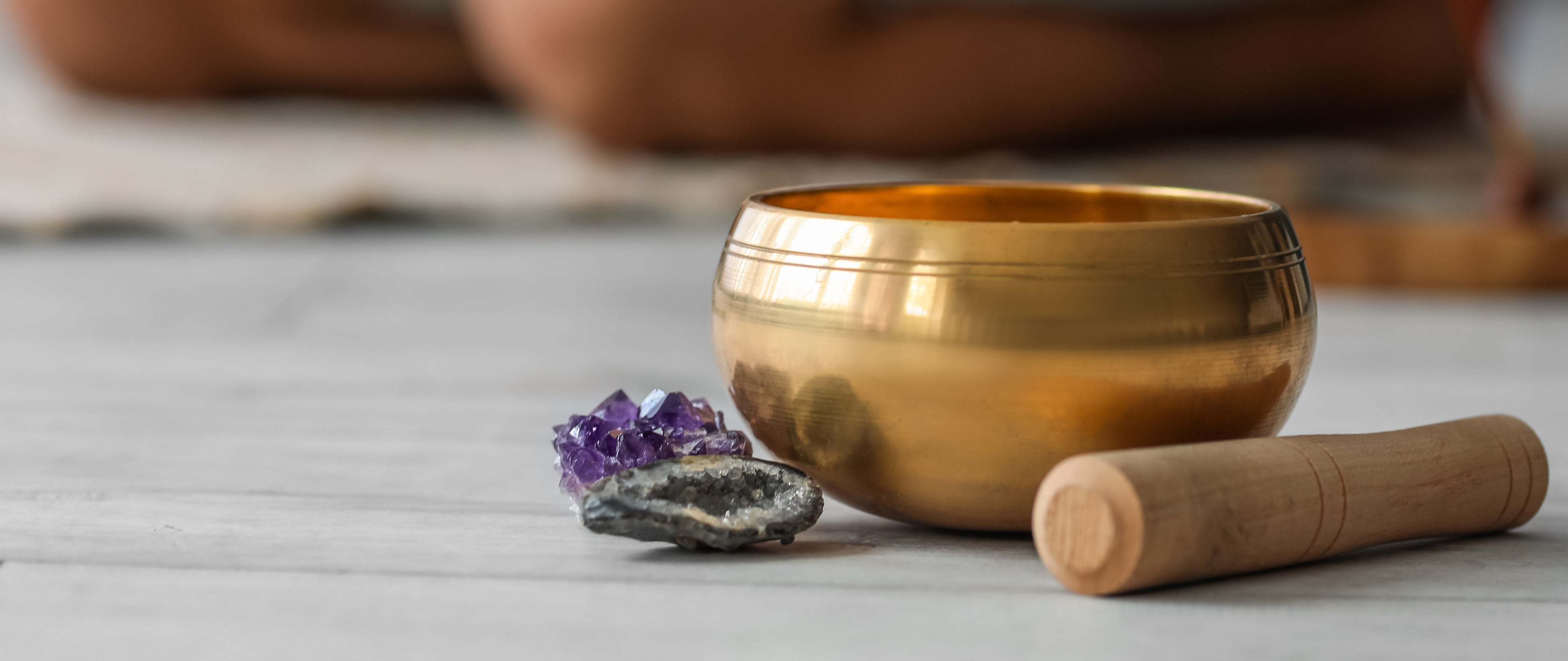Soapstone (alternatively known as Steatite and Soaprock) is one of the earliest stones used in many countries and industries across the world. It was named as such because of its smooth and soap-like texture. With amazing malleability and heat properties, Soapstone holds a number of solid uses in the art and industrial scenes.
Dig deeper into the rock's properties, lore, history, and metaphysical benefits.
The Physical Properties of Soapstone
Soapstone is a metamorphic rock mainly composed of talc as well as other minerals namely chlorite, magnesium, amphiboles, and traces of iron-chromium oxides.
Being a talc-based rock, Soapstone shares the same physical properties with the mineral – it is very delicate, nonabsorbent, nonporous, and resistant to heat, acids, and alkalis.
Soapstone has a hardness value of 1 on the Mohs scale meaning it is very easily scratched by the fingernail. It usually has a white, gray, green, bluish, or brown colour. It is opaque with a greasy luster.
Due to its softness and perfect cleavage, the rock has been used as a material for carving sculptures and inlaid ornaments since ancient times. Its high resistance to acids, alkalis, and stains make Soapstone a suitable material for making cooking pots, cooking slabs, bowls, and plates.

And since it is able to absorb, store, and radiate heat, the rock is an excellent material for creating wood-burning stoves. Soapstone is also widely used in making tiles and wall panels for tubs, showers, and backsplashes because it is dense, has no pores, and repels water.
Soapstone's mineral composition may vary depending on factors like the material of the parent rock and the temperature or pressure conditions of its metamorphic environment. This means the physical properties of the Soapstone can vary from one quarry site to another, and within a single rock unit.
Its grain size is also determined by the level of metamorphism through which the rock is created. Fine-grained Soapstones are perfect for intricately designed carvings. Its mineral content can also impact its hardness level.
The History of Soapstone
Soapstone forms at the convergent plate boundaries, specifically at the areas where the Earth's crust is subjected to heat and pressure. It can also form through metasomatism (the process where a hydrothermal or other chemical fluids alter the chemical composition of a rock) occur in dolostones.
The use of this soft rock for various applications traces back to as early as the Late Archaic Period (or between 3,000 and 5,000 years ago). In North America, native Americans fashioned Soapstone into bowls, cooking slabs, and smoking pipes.
Native Americans who lived on the west coast would travel 60 miles from the mainland to San Clemente Island to quarry Soapstone so they could create cooking bowls and effigies. In ancient Egypt, the rock is carved into seals and scarabs.
In China and India, it is used for making ornaments and utensils. In Canada, Soapstone has been used for similar applications by the First Nations, Norse, and Inuit over the past 7,500 years.

Around 2.6 million years ago, Soapstone was an indispensable carving material for Scandinavians during the Stone Age. They carved the rock into molds for creating weapons like spearheads and knife blades. Scandinavians were one of the first peoples to discover the thermal properties of Soapstone. This discovery led them to shape the rock into bowls, cooking slabs, and cooking pots.
Today, Soapstone is used for making sinks, kitchen countertops, floor tiles, and many other products. The famed ˜Christ the Redeemer' statue that towers over the city of Rio de Janeiro in Brazil is perhaps the grandest proof of Soapstone's ability to be used as a sculpture material. The 120-feet tall statue is made of reinforced concrete and Soapstone.
Soapstone can be found all over the world, but the most significant deposits are in India, China, Brazil, as well as Canada, Australia, England, Switzerland, and the United States.

The Lore of Soapstone
Soapstone has a calming and balancing effect, while it creates positive, stimulating energy. It creates an openness for new possibilities in life and supports the release of old routines.
The stone is also a reminder of how physical objects and creations can be carved out of human intentions and imaginations (with the popular Soapstone figurines).
The Metaphysical Properties of Soapstone
Soapstone gives strength to people going through changes in life, empowering them to seize new opportunities and adventures, and they resonate with flexible and creative freedom. It promotes artistic and rational thinking, logic, and truth.
The stone is believed to help with breaking off from old and outdated habits and patterns, assisting its owner in finding a better, more constructive path.
During a process of physical or emotional change, it is good to have the stone around you because it will help retain a sense of calm and positivity and open the connection to other realms of existence. That way, Soapstone encourages a more inspired and broadminded approach to life. Its energy aids in transmitting messages across all energy fields and realms by amplifying the signal received.
As for the physical benefits, it is said that Soapstone balances the digestive system and reduces skin rashes, irritation, allergies, and sunburns.
Note: There is no scientific evidence that supports the effectiveness of mineral stones and crystals in treating ailments. All information published here is purely for educational purposes.
Scientists attribute the healing impact to the placebo effect that takes place when using stones and crystals. Holding stones and meditating with them is said to trigger the release of feel-good hormones (endorphins and dopamine) in the brain.
Sources:
King, H. (n.d.). Soapstone. Geology.com. Accessed at https://geology.com/rocks/soapstone.shtml
Soapstone. (2021, June 19). Wikipedia.com. Accessed at https://en.wikipedia.org/wiki/Soapstone
Soapstone. (2006, February 7). The Canadian Encyclopedia. Accessed at https://www.thecanadianencyclopedia.ca/en/article/soapstone
Soapstone Meanings and Properties. (n.d.). Fire Mountain Gems and Beads. Accessed at https://www.firemountaingems.com/resources/encyclobeadia/gem-notes/hb0c
What is Soapstone? (n.d.). Artistic Tile & Stone. Accessed at https://www.artistictile.net/store/info-soapstones.html
Dolostone. (n.d.). Science Direct. Accessed at https://www.sciencedirect.com/topics/earth-and-planetary-sciences/dolostone
Rocks, Metamorphic Rocks, and Metamorphic Environments. (n.d.). Asbury Carbons. Accessed at https://asbury.com/resources/education/graphite-101/rocks-metamorphic-rocks-and-metamorphic-environments/





